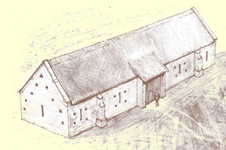| HOME News Terminology Contact |


Tithe Barn, Pilton


Name: Tithe Barn, Pilton
Status: Grade I Listed and Scheduled Ancient Monument
Address: Cumhill Farm, Cumhill, Pilton, Shepton Mallet, Somerset BA4 4BG
The Tithe Barn, Pilton is thought to date back to the thirteenth century and originally belonged to Glastonbury Abbey. It is one of four surviving barns originally attached to the abbey.
The barn, with an arched braced, base cruck roof is a dominant structure on Cum Hill, forming part of the farmyard at Cumhill Farm. After the Reformation, the barn was used as a general ram building up until 1963, when the barn was struck by lightning, destroying the thatched roof and timbers. It remained in a bad state of repair for a number of years until funds were given by Michael Eavis generated by proceeds from the Glastonbury Festival.
Traditional methods and materials were used during restoration (started in 1994 and completed in 2005) and care was taken to restore the barn to its original specifications. English oak beams from Northumberland were used and a tile roof reinstated instead of the later thatch. The work won the prestigeous 'Wood Award', which recognises and encourages outstanding design, craftmanship and installation in joinery and structures in wood. McCurdy & Co were brought in by the Pilton Barn Trust as specialist advisors and principle contractors for the roof work, to be responsible for the research, design and construction. Large curved timber beams, called crucks, and other structural timbers comprising the complex roof structure were cut and shaped from green oak. To ensure the deformed walls could support the roof, the University of Bath carried out on-site testing of the buttresses and laboratory testing of the arched brace joint.
A lime concrete floor was laid after hard-standing and rubble infill were removed and a 3 metre wide strip, between the two doors, was re-laid in Blue Lias Stone, filled either side with lime concrete. It is thought to be the largest expanse of lime concrete flooring in Europe.
On Friday 1 April, 2005, the barn was officially opened by local historian Sir John Keegan, one of the original supporters of the restoration project. As well as working as a real farm building, the barn is also used for public events.





DIRECTIONS
Approaching Pilton from Glastonbury on the A361, take the first right turn as the hill starts to climb steeply towards the village. Turn right at the bottom of this lane, and follow it down past the church. You will see black-and-white bollards on your right. Just past here, there is a small area where you can park, and a footpath leading up to the barn.






